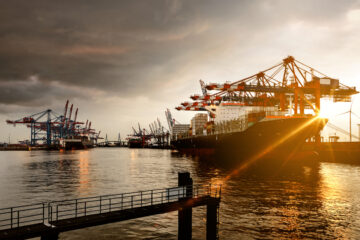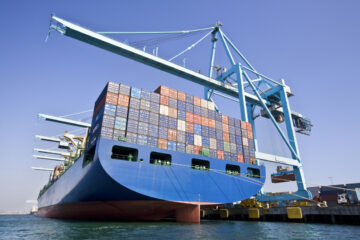2023 was a whirlwind year for the supply chain industry. Countless challenges – from natural disasters to global conflict – forced leaders to reevaluate their operations, seek alternative routes and better prepare for what’s next.
As we make our way into 2024, some key emerging trends should be on the radar of every supply chain leader. While some of these are immediate, some will be seen longer-term.
Sustainability to take a back seat
While there’s been a heavy focus on reducing carbon emissions across the supply chain over the past few years – with a deadline of 2025 for carbon reduction – we will likely see this shift in 2024. Green focus will take a backseat due to inflationary pressure; businesses will focus on ways to keep costs down and reallocate their budgets to do so.
Current disruptions are leaving businesses with very few options to make ends meet, and almost all businesses would focus more on ensuring their chains and subsequent production lines don’t stop.
The Red Sea conflict
One of the most immediate challenges is the conflict in the Middle East. First, companies are seeing exponentially-increasing freight rates:
- South East Asia to EU: 203.92% surge in 20 ft. freight rates from September 2023 ($944) to January 2024 ($2,870)
- India to USA: 32.40% increase in 40 ft. freight rates from September 2023 ($3,629) to January 2024 ($4805)
- Singapore to USA: 331.28% spike in 20 ft. freight rates from September 2023 ($1,310) to January 2024 ($5,650)
Companies are also experiencing unprecedented congestion levels, leading to delays in cargo handling and vessel movements. Between December 2023 and January 2024, the ports of Antwerp, Hamburg, Rotterdam and Algeciras experienced more than double the wait time:
- Antwerp: From 1.5 days average wait to 3+ in December and January
- Hamburg: From an average of 2 days wait in December to almost 6 in January
- Rotterdam: From less than 1.5 days average to almost 3 days in January
- Algeciras: From less than 1 day average to more than 3 days in January
Further, the ongoing Houthi attacks have demonstrated the importance of the Suez Canal in international trade from eastbound to westbound movements. In fact, recent Houthi attacks disrupted 12% of global trade, leaving 129 vessels carrying cargo worth $16.7 billion stranded.
Supply chain leaders must pay extra attention to both the business and political landscapes around major trade channels like the Suez Canal in order to truly be resilient. They should also be prepared for the potential risk of Egypt shutting the Suez Canal long-term.
Climate change impact
While the Red Sea conflict presents immediate concerns, 2024 won’t solely be defined by geopolitical flashpoints. Climate change casts a long shadow over supply chains, threatening disruptions with alarming frequency and intensity. Extreme weather events like floods, droughts and wildfires are increasing 30% faster than they did just two decades ago, jeopardizing transportation infrastructure, agricultural production and manufacturing facilities. The recent drought in Panama, for instance, forced water restrictions on the iconic canal, reducing its capacity by 15% and impacting global trade.
Such incidents are harbingers of a future where climate-related disruptions become the norm. Ignoring this reality puts supply chains at increasing financial risk, with the World Bank estimating climate change could cost developing countries $500 billion annually by 2050.
Building resilience requires proactive measures like investing in sustainable packaging, green logistics and disaster preparedness plans. Businesses that recognize the climate threat and actively mitigate it won’t just be safeguarding their operations, they’ll be gaining a competitive edge in a world increasingly grappling with the consequences of a changing climate.
Strategies for resilience
With these looming challenges, what can supply chain leaders do to remain resilient?
The trend of rightshoring – locating a business’s manufacturing operations in localities and countries that provide the best combination of cost and efficiency – will continue to prevail in 2024 and will ease pressures in some sectors. Rightshoring has been a boon for many developing economies like India, with skilled and affordable labor available to locally produce needed components.
Rightshoring will be paramount to combat the strong overreliance on Chinese production in major sectors like automobiles and electronics, which cannot be replaced as of right now.
Digital solutions to take center stage
In addition to embracing rightshoring, supply chain leaders can navigate these challenges via technology – particularly AI.
Many supply chain leaders have already found value in adopting digital solutions; supply chain track-trace and visibility solutions have taken the industry by storm. However, these solutions don’t just digitize operations; they have built the foundation for mining immense data of container movements globally. This has resulted in building a plethora of applications on top of core data like container arrivals, vessels and AIS locations, for example.
By leveraging AI and machine learning algorithms, businesses can process this raw data to derive insights that can help improve their on-ground operations and decisions. For example, mining the data of millions of containers businesses can identify container hotspots to mitigate container shortages; suggest better sourcing via different routes to achieve faster deliveries; and learn about on-ground performance for carriers and ports to save money when negotiating with terminals, ports and carriers.
Although Covid drove the digitization of supply chains, the result is a technological foundation for data-led decision making. The hidden edge lies in finding applications to use this data, supported by artificial intelligence, to build decision-making support systems that can optimize supply chains at scale.
The bottom line
Supply chain disruptions are nothing new. But geopolitical tensions leading to increased freight rates and delays have created a scenario for 2024 whereby supply chain leaders must utilize groundbreaking AI technologies to optimize their supply chains, decrease shipping times and maximize their bottom line.
About the author
 Gautam Jain is CEO at GoComet, a logistics resource management software platform that helps large enterprises transform their supply chain operations.
Gautam Jain is CEO at GoComet, a logistics resource management software platform that helps large enterprises transform their supply chain operations.
- SEO Powered Content & PR Distribution. Get Amplified Today.
- PlatoData.Network Vertical Generative Ai. Empower Yourself. Access Here.
- PlatoAiStream. Web3 Intelligence. Knowledge Amplified. Access Here.
- PlatoESG. Carbon, CleanTech, Energy, Environment, Solar, Waste Management. Access Here.
- PlatoHealth. Biotech and Clinical Trials Intelligence. Access Here.
- Source: https://www.allthingssupplychain.com/supply-chain-predictions-for-2024/?utm_source=rss&utm_medium=rss&utm_campaign=supply-chain-predictions-for-2024
- :has
- :is
- :where
- $3
- 1
- 15%
- 2%
- 20
- 2023
- 2024
- 2025
- 2050
- 225
- 300
- 40
- 5
- 6
- 7
- a
- About
- Achieve
- across
- actively
- addition
- Adopting
- affordable
- ago
- Agricultural
- AI
- ais
- algorithms
- All
- almost
- already
- also
- alternative
- an
- and
- Annually
- applications
- ARE
- around
- artificial
- artificial intelligence
- AS
- asia
- At
- Attacks
- attention
- automobiles
- available
- average
- back
- Bank
- BE
- become
- been
- BEST
- Better
- between
- Billion
- both
- Bottom
- Budgets
- build
- Building
- built
- business
- businesses
- but
- by
- CAN
- cannot
- Capacity
- carbon
- carbon emissions
- Carbon Reduction
- Cargo
- carriers
- carrying
- Center
- ceo
- chain
- chains
- challenges
- change
- changing
- channels
- chinese
- Climate
- Climate change
- combat
- combination
- Companies
- competitive
- components
- Concerns
- conflict
- congestion
- Consequences
- Container
- Containers
- continue
- Core
- Cost
- Costs
- could
- countless
- countries
- Covid
- created
- data
- day
- Days
- deadline
- decades
- December
- decision
- Decision Making
- decisions
- decrease
- defined
- delays
- Deliveries
- demonstrated
- derive
- developing
- Developing Countries
- DID
- different
- digital
- digitization
- digitize
- disaster
- Disaster Preparedness
- disasters
- disrupted
- disruptions
- do
- Dont
- double
- down
- Drought
- due
- ease
- East
- economies
- Edge
- efficiency
- Egypt
- Electronics
- embracing
- emerging
- Emissions
- ends
- ensuring
- enterprises
- EU
- events
- Every
- example
- experienced
- experiencing
- extra
- extreme
- facilities
- fact
- faster
- few
- financial
- finding
- First
- Focus
- For
- forced
- found
- Foundation
- freight
- Frequency
- from
- FT
- future
- gaining
- geopolitical
- Global
- global trade
- Globally
- grappling
- Green
- groundbreaking
- hamburg
- Handling
- Have
- heavy
- help
- helps
- Hidden
- High
- However
- HTTPS
- iconic
- identify
- immediate
- immense
- impacting
- importance
- improve
- in
- incidents
- Increase
- increased
- increasing
- increasingly
- india
- industry
- Inflationary
- Infrastructure
- insights
- instance
- Intelligence
- International
- International Trade
- into
- investing
- IT
- ITS
- January
- jpg
- just
- Keep
- Key
- labor
- landscapes
- large
- Large enterprises
- leader
- leaders
- leading
- LEARN
- learning
- leaving
- less
- levels
- leveraging
- lies
- like
- likely
- Line
- lines
- locally
- locating
- locations
- logistics
- Long
- long-term
- looming
- machine
- machine learning
- major
- make
- Making
- management
- management software
- manufacturing
- many
- max-width
- Maximize
- measures
- Meet
- Middle
- Middle East
- millions
- Mining
- Mitigate
- money
- more
- most
- movements
- must
- Natural
- Navigate
- needed
- New
- next
- nothing
- now
- of
- on
- ongoing
- Operations
- Optimize
- Options
- order
- our
- over
- packaging
- Panama
- Paramount
- particularly
- past
- Pay
- performance
- plans
- platform
- plato
- Plato Data Intelligence
- PlatoData
- plethora
- political
- ports
- potential
- Predictions
- Prepare
- prepared
- presents
- pressure
- pressures
- Proactive
- process
- produce
- Production
- Profile
- provide
- Puts
- radar
- Rates
- Raw
- raw data
- Reality
- recent
- recognize
- Red
- reducing
- reduction
- reevaluate
- remain
- replaced
- requires
- resilience
- resilient
- resource
- restrictions
- result
- resulted
- right
- Risk
- routes
- safeguarding
- Save
- Scale
- scenario
- SEA
- Sectors
- see
- seeing
- Seek
- seen
- September
- Shadow
- shift
- Shipping
- shortages
- should
- skilled
- So
- Software
- software platform
- solely
- Solutions
- some
- Sourcing
- spike
- Stop
- Storm
- strong
- subsequent
- suggest
- supply
- supply chain
- Supply chains
- support
- Support Systems
- Supported
- surge
- sustainable
- Systems
- Take
- taken
- technological
- Technologies
- Technology
- tensions
- than
- that
- The
- the world
- their
- These
- they
- this
- threat
- threatening
- time
- times
- to
- top
- trade
- Transform
- transportation
- Trend
- Trends
- truly
- two
- unprecedented
- USA
- use
- utilize
- value
- very
- Vessel
- vessels
- via
- visibility
- wait
- was
- Water
- Way..
- ways
- we
- Weather
- What
- when
- which
- while
- whirlwind
- will
- with
- world
- World Bank
- worth
- would
- year
- years
- zephyrnet










